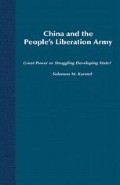Abstract
Acurrency that has never been completely convertible, the continued existence of nonmarket inputs and outputs, and deliberately opaque information are among the most obvious problems that plague analyses of China’s defense budget. Analyses of historical changes in defense spending are further hampered by incomplete information not only about components of defense spending but also about changes over time in how the components are calculated and presented.
Access this chapter
Tax calculation will be finalised at checkout
Purchases are for personal use only
Preview
Unable to display preview. Download preview PDF.
Notes
Deng Liqun et. al., eds., The Chinese People’s Liberation Army. Vol. I (Beijing: Contemporary China Publishing House, 1994), p. 669.
Liu Rongpu, “Some Considerations on the Inputs of Military Expenditure” (dui junfei touruu de jidian sikao), Military Sciences Economic Review (junshi jingji yanjiu) 1996 (5), pp. 39–40.
Liu Yichang and Wu Xizhi, eds., The Basics of National Defense Economic Studies Beijing: Military Sciences Publishing House (junshi kexue chubanshe) 1991, p. 217.
See for example Richard D. Fisher (Senior Policy Analyst, the Heritage Foundation), “China’s Purchase of Russian Fighters: A Challenge to the U.S.,” Heritage Foundation press and internet release, July 31, 1996.
Fang Jizuo et. al., “On the Legalization of Defense Expenditure Management,” Military Sciences Economic Review (junshi jingji yanjiu) 1995 (8), p. 40.
Liu Yichang and Li Lin, “On Construction of Defense Economics under Market Conditions” (lun shichang jingji tiaojian xia de guofang jingji jianshe), Military Sciences Economic Review (junshi jingji yanjiu) 1996 (3), p. 10.
Wu Yubang, “The Centralized Nature of Financial Management and Centralized and Unified Leadership of the Army” (caiwu guanli de jizhongxing yu jundui jizhong tongyi lingdao), in Li Lin and Zhao Qinxuan, eds., Theory and Research on Military Economics in the New Era (xinshiqi junshi jingji lilun yanjiu), (Beijing: Military Sciences Publishing House, 1995), p. 55.
Li Jinggong, “Briefly on Improving Military Expenditure Supply” (xiantan gaijin xianxing junfei gongying fangfa), Military Sciences Economic Review (junshi jingji yanjiu) 1995 (11), pp. 42–45.
Jin Zhude and An Weimin, “[Employing} Twice the Development and Key Deployment of National Defense Resources: A New Exploration on the Concept of Defense Conversion” (guofang ziyuan de arci kaifa he zhongxin peizhi: dui junzhuanmin gainian de xin tansuo), Chinese Military Industry News (zhongguo jungong bao) September 6, 1996, p. 3.
Copyright information
© 2000 Solomon M. Karmel
About this chapter
Cite this chapter
Karmel, S.M. (2000). Trends in Chinese Defense Spending and the Illusive Goal of Modernization. In: China and the People’s Liberation Army. Palgrave Macmillan, New York. https://doi.org/10.1007/978-1-349-62319-8_5
Download citation
DOI: https://doi.org/10.1007/978-1-349-62319-8_5
Publisher Name: Palgrave Macmillan, New York
Print ISBN: 978-1-349-62321-1
Online ISBN: 978-1-349-62319-8
eBook Packages: Palgrave Political & Intern. Studies CollectionPolitical Science and International Studies (R0)

